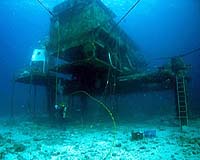 |
Bonn, Germany (SPX) May 12, 2011 The camera system on board the Dawn spacecraft has acquired its first image of the massive asteroid Vesta. Although the mission's first target is still about 975,000 kilometres away, appearing as just a large white dot, "we now have visual contact with our objective," said Ralf Jaumann of the German Aerospace Center (DLR). In August 2011, the camera will photograph the asteroid from an orbit with a planned survey altitude of 2700 kilometres; the data will then be processed to develop a three-dimensional model. It has taken the NASA spacecraft over 43 months, during which it has travelled 2.6 billion kilometres, to come within imaging range of the irregularly shaped asteroid. The image acquired on 3 May 2011 shows the asteroid, which has a diameter of about 530 kilometres, as a white dot against a background of stars. Dawn will use its framing cameras over the next three months to navigate the approach and orbital capture by Vesta. "We are no longer flying without sight of our target," said Jaumann, head of the Planetary Geology Department at DLR's Institute of Planetary Research in Berlin. The camera system has now successfully demonstrated the first of its two functions by providing navigational data. "It is now clear that the camera system is working flawlessly and can fulfil its purpose as a navigation instrument." The images obtained with the framing cameras will now be used to determine the exact relative trajectory of the spacecraft, and significantly improve its guidance and control to Vesta. According to current calculations, on 16 July 2011, Vesta will capture Dawn into orbit. The spacecraft will study the asteroid for roughly a year.
An asteroid in three dimensions Although the appearance of the asteroid's surface is as yet unknown, it is thought likely that it has a solid crust similar to that of the Moon. The camera technologies have been exercised on the Rosetta, Mars Express and Venus Express missions. DLR's planetary scientists will process the data obtained with the cameras as Dawn orbits Vesta at different altitudes. The resulting terrain model will answer questions about Vesta's birth, geological history and battering by other asteroids.
The Dawn mission The camera system on the spacecraft was developed and built under the leadership of the Max Planck Institute for Solar System Research in Katlenburg-Lindau, Germany, with significant contributions from the German Aerospace Center (DLR) Institute of Planetary Research in Berlin and the Institute of Computer and Communication Network Engineering in Braunschweig. The Framing Camera project is funded by the Max Planck Society, DLR, and NASA/JPL.
Share This Article With Planet Earth
Related Links German Aerospace Center (DLR) Asteroid and Comet Mission News, Science and Technology
 Engineering Tests Leading The Way For NASA's Next Neemo Mission
Engineering Tests Leading The Way For NASA's Next Neemo MissionHouston TX (SPX) May 10, 2011 To determine how best to explore asteroids in the future, NASA scientists and engineers are taking their experiments underwater in the 15th expedition of NASA Extreme Environment Mission Operations, or NEEMO. This year's NEEMO expedition, which will include the usual compliment of astronauts and engineers, is slated for October. Since this is the first mission to simulate a trip to an aste ... read more |
|
| The content herein, unless otherwise known to be public domain, are Copyright 1995-2010 - SpaceDaily. AFP and UPI Wire Stories are copyright Agence France-Presse and United Press International. ESA Portal Reports are copyright European Space Agency. All NASA sourced material is public domain. Additional copyrights may apply in whole or part to other bona fide parties. Advertising does not imply endorsement,agreement or approval of any opinions, statements or information provided by SpaceDaily on any Web page published or hosted by SpaceDaily. Privacy Statement |